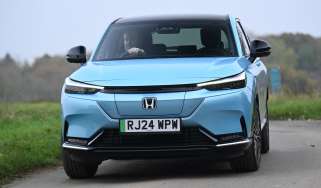Renault Scenic - Design, interior & technology
The cabin layout is restrained, but the Scenic has a logical layout and user-friendly tech

The exterior of the Renault Scenic taps into the themes of the Scenic Vision concept of 2022, designed by Gillas Vidal. The light units front and rear adopt an aggressive and bold design, and unlike the black-painted concept, the lighter colours available on the Scenic show up the car’s sharp surfacing very well. The selection of alloy wheel designs is interesting.
As with the old Scenic people carrier, the latest electric SUV shares tech with the Mégane, but adds more space into the mix.
What is the Renault Scenic like inside?
Renault’s latest corporate look includes plenty of sharp angles and slender lights, and the Scenic mixes these with SUV proportions to cut a real dash on the road.
The angular theme continues inside, where the upright dashboard, with a portrait touchscreen and landscape driver’s display, dominates. There’s a decent mix of materials, though, with light-coloured seat fabrics and white armrests breaking up the black.
What is the interior quality like?
Different types of plastic are used throughout the cabin, with traditional hard, black trim on the lower doors and the centre console, and softer materials on the dashtop and upper doors.
The lighter parts feel good to touch, while the upholstery is made from recycled fabrics and is an acceptable substitute for leather, which isn’t even offered as an option.
Used - available now

2022 Ford
Kuga
30,122 milesAutomaticDiesel1.5L
Cash £20,400
2025 Fiat
500e
26,634 milesAutomaticElectric
Cash £10,700
2019 BMW
5 Series
80,675 milesAutomaticDiesel2.0L
Cash £17,997
2022 Nissan
Qashqai e-POWER
36,409 milesAutomaticPetrol1.5L
Cash £17,897Even the steering wheel is trimmed in synthetic material, although it feels like soft leather in your hands. One minor gripe is with the driver’s air vent, which is of a different design to the others on the dashboard, and feels a little clunky to use.
Sat-nav, stereo and infotainment
The two large displays on the dashboard feature super-sharp graphics and neat animations, while there’s plenty of information on the driver’s display. This can be configured into different layouts, although we’d recommend choosing one and sticking to it, because switching from one to another can shuffle the layout around, leaving vital information such as your speed in a different position that makes it hard to pick out. There are various colour themes offered, while the shortcut toggle switches beneath the main display are handy.
Renault’s OpenR Link system runs on a 12-inch portrait display in the Scenic and features crisp graphics, while the Google operating system is familiar from other recent Renaults. It’s quick to load, and the standard Google Maps software is just as effective as the firm’s smartphone app at rerouting to avoid traffic.
There are shortcut keys at the top of the main display to make navigating the system easier, while the climate controls use a mix of quick-access physical buttons and more in-depth touchscreen functions.
Top-spec Iconic cars are fitted with what Renault calls its Solarbay roof. This is a panoramic glass panel that incorporates an electrochromatic layer that can turn from clear to opaque at the push of a button. It transforms in steps front to rear, which is a neat show for back-seat occupants to watch.
Fitting a digital rear-view mirror is a useful addition because it overcomes poor rear visibility, but not everybody can get along with this type of set-up. If you need to wear corrective glasses, it can be tricky to refocus on the screen rather than looking into a conventional mirror. At least it’s switchable here. Some cars have the camera for the digital mirror mounted on the roof or tailgate, but the Scenic’s is behind the rear window. Here it can mist up, and you need to use the rear wiper to keep it clear of rain and dirt.
Renault requested the help of musician Jean-Michel Jarre to develop some sounds for the Scenic. The first is a ‘VSP’ (vehicle sound for pedestrians) that warns people when the car is approaching at speeds under 18mph, and the second is a welcome sound sequence when you turn the car on. Sadly for 1980s electronica fans, Jarre was not involved in developing the nine-speaker Harman Kardon sound system which is found as standard on the highest-specification Iconic trim.









